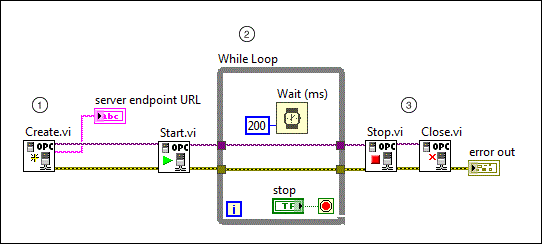
M_OPCConnPointCntnr.FindConnectionPoint(ref guidDataCallback, out m_OPCConnPoint)

GuidDataCallback = Marshal.GenerateGuidForType(typeof(IOPCDataCallback)) M_OPCConnPointCntnr = (IConnectionPointContainer)m_OPCGroup2 M_OPCGroup2.SetKeepAlive(iKeepAliveTime, out iKeepAliveTime) Out m_iServerGroup, out iRevisedUpdateRate, IClientGroup, ptrTimeBias, ptrDeadBand, iLCID, M_OPCServer.AddGroup(sGrpName, (bActive) ? 1 : 0, iUpdateRate, GuidGroupStateMgt = Marshal.GenerateGuidForType(typeof(IOPCGroupStateMgt2)) Because each group's threads are created in the OPC server, please note that CPU load increases by too many subdivisions.
#NI OPC SERVER SETUP UPDATE#
Data update cycles can be set as group objects, and are typically registered with the same synchronously accessed device. Group objects need to be created in the OPC server to retrieve actual data from outside. IOPCCommon m_com = (IOPCCommon)m_OPCServer Create an OPC group and add labels M_OPCServer = (IOPCServer)CreateInstance(clsidList, sNodeName) SvrList.CLSIDFromProgID(sSvrName, out clsidList) IOPCServerList svrList = (IOPCServerList)CreateInstance(CLSID_SERVERLIST, null) Connect to OPC Server via COMĬreate an instance of a COM connection, specify the CLSD of the OPC server, and you can get each interface pointer of the OPC, such as the OPC server object and browsing object. NET uses RCW (Runtime Callable Wrapper) to access the OPC server here. For integrated applications, as long as the OPC interface is supported, physical devices can be easily accessed without the need for relevant technical information.

F The physical devices are connected to the OPC Server. That is to say, through these interfaces, the client can get the information o.

OPC Server provides an OPC interface, which returns the information value of the connected physical device (PLC) to the client application through the interface. OPC Server It is a framework that uses Microsoft COM/DCOM technology to achieve industrial automation data acquisition.


 0 kommentar(er)
0 kommentar(er)
